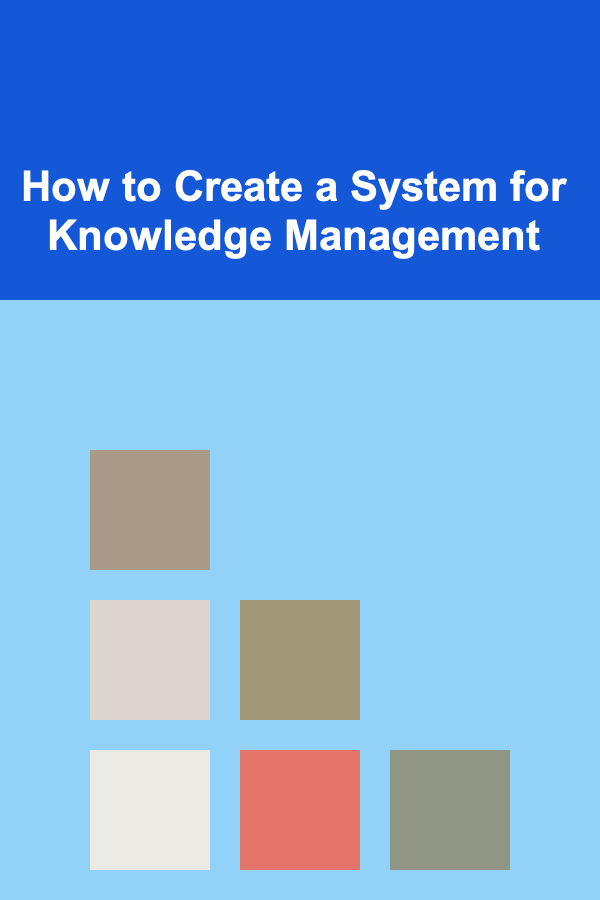
How to Create a System for Knowledge Management
ebook include PDF & Audio bundle (Micro Guide)
$12.99$7.99
Limited Time Offer! Order within the next:

Knowledge management (KM) refers to the systematic approach to capturing, organizing, sharing, and utilizing knowledge within an organization. As businesses and institutions evolve, the amount of information they generate grows exponentially. A well-organized and effective knowledge management system can help organizations harness the power of their intellectual capital, improve decision-making, increase productivity, and drive innovation. This article explores how to create a robust system for knowledge management, the components that make it effective, and best practices for implementing it.
Understanding Knowledge Management
Before diving into the specifics of building a knowledge management system, it's important to define what knowledge management is and why it is crucial for modern organizations.
Knowledge management is a process that involves identifying, capturing, and sharing knowledge within an organization to ensure that valuable information is readily accessible. This knowledge can come in the form of data, insights, skills, experiences, and know-how, and it plays a vital role in fostering innovation, improving operations, and staying competitive.
Effective knowledge management systems typically include both technological tools and processes that allow employees to contribute, access, and apply knowledge in a seamless manner. These systems not only help preserve organizational knowledge but also ensure that it can be efficiently leveraged for problem-solving, decision-making, and continuous improvement.
Defining the Purpose and Goals of Knowledge Management
Every organization has unique needs and challenges when it comes to managing knowledge. Before creating a knowledge management system, it is essential to define clear objectives that align with the overall business strategy. Some common goals for KM systems include:
- Improved decision-making: By providing easy access to relevant knowledge, employees can make more informed decisions.
- Enhanced collaboration: A good KM system fosters teamwork and cross-departmental collaboration by making it easier for employees to share expertise and insights.
- Innovation and continuous improvement: KM systems help organizations capture lessons learned, best practices, and new ideas, contributing to innovation and operational improvements.
- Knowledge retention: In industries where employee turnover is high, knowledge management ensures that important expertise is not lost when employees leave.
- Efficiency and productivity: By reducing the time spent searching for information, a KM system can increase productivity and streamline workflows.
Understanding these goals will help you build a knowledge management system that addresses your organization's specific needs.
Identifying and Categorizing Knowledge
One of the key steps in building a knowledge management system is understanding the types of knowledge within your organization and categorizing it appropriately. Knowledge in organizations typically falls into two broad categories:
- Explicit knowledge: This is codified, documented knowledge that can be easily shared and transferred. It includes manuals, reports, databases, standard operating procedures, and written documentation. Explicit knowledge is usually stored in digital systems and can be accessed quickly.
- Tacit knowledge: This is the knowledge embedded in individual experiences, skills, and insights. Tacit knowledge is often difficult to document and share because it is personal and intuitive. It includes things like problem-solving techniques, expertise gained through experience, and the way individuals approach tasks. Tacit knowledge is usually shared informally, through conversations, mentorship, and collaboration.
To create an effective KM system, it is essential to identify both types of knowledge within the organization and consider how to capture, organize, and share them.
Explicit Knowledge
Explicit knowledge is the easiest to capture and manage because it is usually documented and stored in a specific format. However, the sheer volume of explicit knowledge can make it challenging to manage. Here are a few strategies to organize it effectively:
- Create a centralized repository: Build a knowledge base or document management system where employees can easily store, search, and retrieve important documents. Organize the knowledge base by categories such as department, function, or topic.
- Use metadata and tagging: Adding metadata and tags to documents allows users to quickly search for relevant information. Consistently tagging documents ensures that they can be located based on content and context, not just file names.
- Ensure version control: As documents and knowledge evolve, it is important to keep track of changes to avoid confusion. Version control ensures that users are always accessing the most up-to-date information.
Tacit Knowledge
Tacit knowledge is more challenging to manage because it is not easily captured or documented. However, there are several strategies that organizations can use to make tacit knowledge more accessible:
- Mentoring and coaching: Encourage experienced employees to mentor and coach less-experienced ones. This can help transfer tacit knowledge in a more informal, personalized manner.
- Communities of practice: Create forums or communities where employees with similar interests or expertise can share experiences, ask questions, and collaborate. These communities foster knowledge-sharing and allow tacit knowledge to be passed on through discussions.
- Job shadowing and collaborative work: Encourage employees to work together, shadow one another, and learn from each other in real-time. Collaborative projects can also serve as an opportunity for tacit knowledge exchange.
- Storytelling: Encourage employees to share their experiences and lessons learned in a storytelling format. This can be a powerful way of transferring tacit knowledge, as it allows the person sharing the knowledge to provide context and examples.
Choosing the Right Technology
A successful knowledge management system relies heavily on the right technology. There are various tools and platforms that can facilitate the management of both explicit and tacit knowledge. Some essential technological components include:
Knowledge Management Software
This software provides the backbone for storing and organizing explicit knowledge. Popular knowledge management software includes:
- Document management systems (DMS): These systems allow employees to store, organize, and retrieve documents easily. Some examples include Microsoft SharePoint, Google Drive, and Dropbox.
- Knowledge bases: Platforms like Confluence, Zendesk, and Notion provide a centralized location where employees can document processes, FAQs, and how-to guides.
- Enterprise content management (ECM): ECM platforms like M-Files and Box help organizations manage the lifecycle of content, from creation to archiving, ensuring that content is accessible and secure.
Collaboration Tools
Collaboration tools are essential for facilitating communication and knowledge-sharing among employees, especially when dealing with tacit knowledge. These tools include:
- Slack: A messaging platform that allows employees to communicate in channels based on topics, projects, or departments. Slack facilitates informal knowledge-sharing and real-time collaboration.
- Microsoft Teams: A collaboration platform that integrates with other Microsoft Office tools, making it easy for teams to collaborate, share files, and hold virtual meetings.
- Trello and Asana: Project management tools that allow employees to work together on projects, share documents, and track progress. These tools are useful for managing collective knowledge within project teams.
Search and Retrieval Systems
An effective knowledge management system must include robust search and retrieval capabilities. Employees should be able to find relevant information quickly. Some essential features include:
- Full-text search: Allows employees to search through all documents and content, rather than just titles or tags.
- Advanced filters and sorting: Features that allow users to filter search results by date, category, or relevance, improving the search experience.
- AI-powered search: Artificial intelligence and machine learning algorithms can be integrated to improve search results, even suggesting relevant documents based on past search history or user behavior.
Creating Processes and Guidelines
A knowledge management system is only as effective as the processes and guidelines surrounding it. Without clear processes, knowledge can become siloed, outdated, or difficult to find. Consider the following:
Knowledge Capture
Establish procedures for capturing knowledge from employees. This includes:
- Encouraging employees to document important information and best practices.
- Setting up regular knowledge-sharing sessions, where employees share insights from projects or challenges they have faced.
- Creating templates and guides to help employees structure and share their knowledge consistently.
Knowledge Sharing
Foster a culture of knowledge-sharing within the organization. This can be done by:
- Offering incentives for sharing knowledge, such as recognition or rewards.
- Encouraging collaboration between teams and departments.
- Ensuring that employees are aware of the tools and systems in place for knowledge sharing.
Knowledge Retention
Ensure that knowledge is retained within the organization, especially when employees leave. Some strategies include:
- Developing a succession plan that includes knowledge transfer between departing employees and their replacements.
- Documenting key processes and lessons learned during projects.
- Conducting regular audits of the knowledge base to ensure that outdated or irrelevant information is archived or removed.
Implementing and Scaling the System
Once you have established the structure, tools, and processes for knowledge management, it is time to implement the system across the organization. This requires careful planning, communication, and ongoing support.
Communication and Training
When rolling out the knowledge management system, it is essential to communicate its purpose and benefits to all employees. Provide training sessions to help employees understand how to use the system effectively and encourage adoption.
Ongoing Maintenance
A knowledge management system requires continuous monitoring and updating. Regularly assess the effectiveness of the system and make improvements as needed. This could include updating knowledge repositories, enhancing search features, or providing additional training.
Scaling the System
As your organization grows, your knowledge management system should evolve to accommodate new teams, departments, and knowledge types. Ensure that the system is scalable by selecting flexible tools and processes that can adapt to the changing needs of the organization.
Conclusion
Creating an effective system for knowledge management requires a combination of clear goals, the right tools, processes, and a strong organizational culture of collaboration. By identifying and categorizing knowledge, selecting the right technology, and implementing processes for knowledge capture, sharing, and retention, organizations can create a knowledge management system that enhances decision-making, promotes innovation, and improves overall organizational performance. As the pace of change continues to accelerate in the modern business environment, effective knowledge management will become even more critical in helping organizations stay competitive and thrive.

How to Clean Your Home Efficiently in Under an Hour
Read More
How to Learn Sign Language: A Comprehensive Guide
Read More
How to Make a Checklist for Safety Inspections in Laboratories
Read More
How to Refresh Your Walls with Budget-Friendly Paint and Wallpaper Ideas
Read More
How to Turn Your Garage into a Functional Living Space
Read More
Profiling the Top Remote Work Companies You Should Know
Read MoreOther Products

How to Clean Your Home Efficiently in Under an Hour
Read More
How to Learn Sign Language: A Comprehensive Guide
Read More
How to Make a Checklist for Safety Inspections in Laboratories
Read More
How to Refresh Your Walls with Budget-Friendly Paint and Wallpaper Ideas
Read More
How to Turn Your Garage into a Functional Living Space
Read More